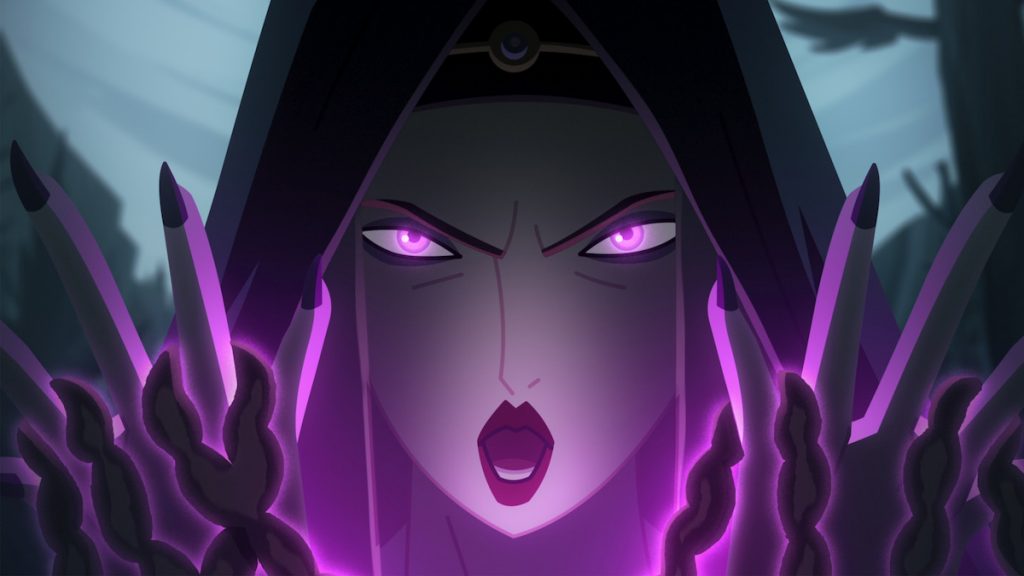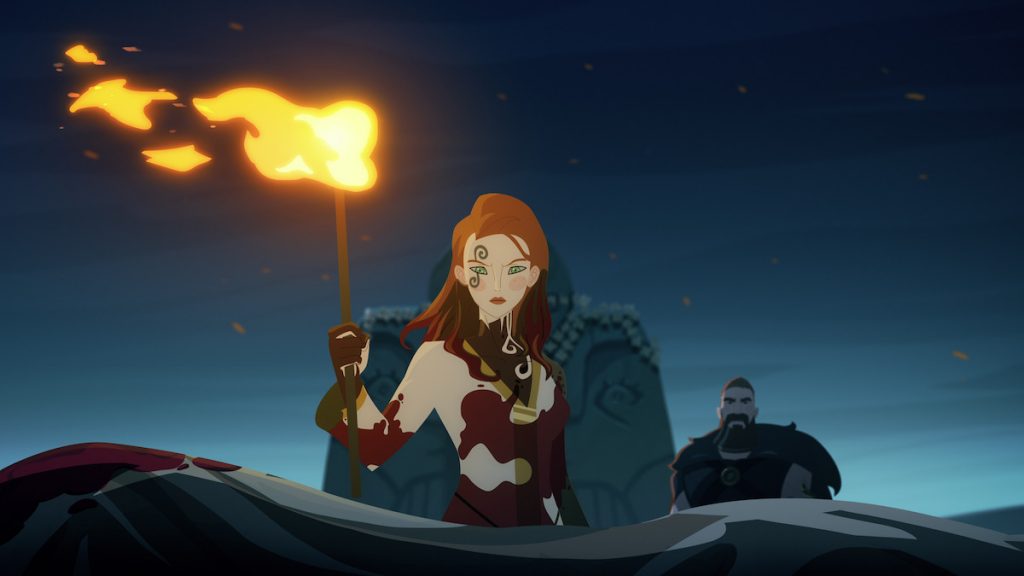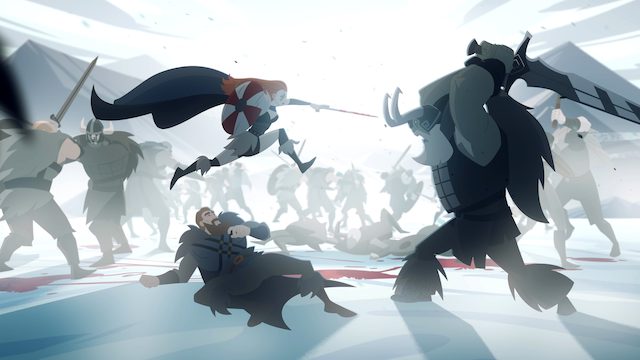With Twilight of the Gods, released on Netflix in September 2024, Xilam took on an ambitious adult animated project on a scale never before attempted at its studio. The story, created by Zack Snyder and Jay Oliva, is inspired by Norse mythology. The series follows Leif, a mortal king, and Sigrid, a warrior with an iron will, on a quest for vengeance against gods and demons. From inhospitable landscapes to bloody battlefields they embark on a perilous journey — a high-tension adventure, driven by love, betrayal and ordeal.
Xilam, known for their work on series like Oggy and the Cockroaches, Space Goofs and Zig & Sharko, is a major player in France’s animation industry, combining creativity and technical expertise since 1999 to create internationally successful animated productions. With more than 2,700 episodes and several feature films, including Jérémy Clapin’s I Lost My Body, nominated for Best Animated Feature Film at the 2020 Academy Awards, the company, founded and managed by Marc du Pontavice, has innovated and expanded the scope of their projects.
With Twilight of the Gods, Xilam had to take on new technical challenges to meet Netflix’s lofty expectations: managing complex battle scenes, integrating 3D into a large-scale 2D project, and creating high quality traditional 2D animation. We met with with Vincent Roche (technical director at Xilam) and Lilian Penzo (deputy technical director of 2D animation) to understand how Twilight of the Gods marked milestones in their respective careers, as well as in the evolution of Xilam itself. They told us about their background, their own experiences in the trenches, and the technical obstacles they overcame to successfully complete this production.
This article was originally written in French by Véronique Dumon with the assistance of Luca Zutz.
Technical directors at the heart of innovation
“I come from 3D productions, but I have been working in animation for fifteen years, exploring different positions in 2D and 3D,” explains Vincent Roche, who has been in his position for nearly seven years. His development has led him to occupy technical director positions, with expertise in complex 3D projects.
Lilian Penzo joined Xilam six years ago as a 2D Rigger leader. “My role today is to set up the necessary pipeline, tools and software to achieve the final design requested,” she says. Lilian prior experience in animation includes work on the Kikoumba series for TF1 at Blue Spirit and The Minimighty Kids at Red Frog studio.
This project represented a new challenge for them. “I have worked on feature films like Titeuf, le film, but Twilight of the Gods remains a big first for me, due to its prestige and its format,” confides Vincent. The unusual format — a series of 8 episodes of 26 minutes created and, in part, directed by the Zack Snyder (whose previous films include 300, Justice League and Rebel Moon) required new skills and organization. Lilian, for her part, also understood the atypical nature of this production in her career, which required all of her expertise in 2D.

The challenges of large-scale production
Twilight of the Gods, originally envisioned as an entirely 3D production, was quickly redesigned in 2D. This strategic reorientation led to reworking all the designs and animatics in 2D within a very tight deadline.
“In 3D, the manufacturing of assets can become very complex and time-consuming, especially when there are a large number of characters with very different sizes and shapes as in this series,” said Vincent Roche. “We have pipelines that we adjust according to the series we produce. There is no single pipeline; we choose the tools that seem best suited to each project.”
The team opted to use Toon Boom Harmony, a tool regularly used by Xilam, particularly for productions requiring rigs or mixing 2D and 3D. With eight episodes to produce (including a 42-minute season finale) and tight deadlines, production spanned two years and involved more than 150 people across Xilam’s four studios.

A collaborative production pipeline
Organized between Xilam Paris and the three satellite studios — Xilam Lyon, Xilam Angoulême and Armada TMT in Vietnam — this collaborative structure made it possible to distribute tasks best suited to the specialties of each studio, an essential point for meeting the deadlines of a large-scale production. The weekly touchpoints between Xilam and Valkyrie, the company created by Zack Snyder, also made it possible to streamline the collaboration.
Lilian Penzo details the process: “After the storyboards, layout and the tracing of the backgrounds, the animation was done mainly in Paris and Lyon. Then Armada, took care of in-betweening, cleanup, and coloring.” The artistic direction of the series was also an adjustment: “Compared to Xilam’s usual productions, which are more cartoon-oriented, Twilight of the Gods had much more detail. We had to find solutions as we went along to simplify certain tasks.”
To meet these demands and save time, the team incorporated 3D elements at several stages of the process. “First, we modeled certain objects in 3D, such as horses, some heads, and weapons. These models were imported into Harmony to serve as reference. The animators could then redraw directly on the model, adjusting the object as necessary.” This method allowed them to maintain the precision and fluidity required by the production, while speeding up the production of particularly complex scenes.
Other solutions combining 2D and 3D were implemented. “For example, for the horses, we created rigs in our 3D software and animated trot and gallop cycles. These cycles were then exported in FBX format to Harmony. There, the animators can use these animated models to redraw each frame of the gallop by emitting the camera as desired,” explains Vincent. H
armony, thanks to its native ability to import 3D objects, was a key asset. This process evolved over the course of production: at first, the 3D was only used as a reference for the animators. Gradually, the team kept certain 3D models until the end of the shots, particularly for objects such as weapons.
A bridge tool with Blender allowed the 3D models to be exported for frame-by-frame rendering, re-imported into Harmony as a colorized 2D sequence. This made it easy to add 2D shadows while maintaining the graphic style and requiring complex 3D treatments. This hybrid approach simplified the process on repetitive elements, while maintaining the flexibility of traditional animation.

A 2D/3D Alliance for Epic Combat
For the crowd and battle scenes featured in the last two episodes of Twilight of the Gods , the team chose to integrate the 3 using the solution from Golaem, a French company founded by Stéphane Donikian that develops crowd creation tools that make it easy to fill 3D scenes with characters or airborne objects, ranging from a few units to thousands. A first for the Xilam studio.
“It’s difficult for a 2D production to animate a large number of characters simultaneously,” said Vincent Roche. The clashes between thousands of characters required a suitable solution. Golaem, integrated into Maya, made it possible to simulate the movements of soldiers in a realistic way. The creation of 3D assets being a time-consuming step, it was only used for the basic soldiers, the heroes and heroines being too varied and different.
Once the soldiers were created in 3D and the battle scenes simulated, the scenes were imported into Harmony so that the team could animate the other characters in 2D. “This required some work to parallelize the pipeline,” Vincent said. “This is something we’ve done on other projects before, but not on this scale.”
The project required 300 shots where 2D and 3D coexist, and each shot required careful management to coordinate the two formats while ensuring a seamless result. “What’s new here is the intensity of this work,” he said.

Xilam reaches new milestones
The project allowed Xilam to once again showcase their team’s abilities outside of children’s animation. As with I Lost My Body, Twilight of the Gods reinforced the studio’s capabilities in ambitious adult animated projects, which required new talent. “The scale of the project forced us to recruit new artists, particularly experts in this style,” explains Vincent Roche. The existing teams were also enthusiastic about the idea of participating in a more adult, action-oriented project, which created a buzz within the studios.
Lilian Penzo emphasizes that this project has been a constant learning opportunity. Each stage of the project has allowed us to become aware of what could be improved, often discovering aspects that had not been anticipated at the beginning. This has led the technical team to review its way of thinking and working, and involved the creation of new tools. It was a process that required creativity, flexibility and expertise at every step of the way.

- Interested in seeing more from Xilam? Be sure to visit the studio’s website.
- Want to watch the full series? Twilight of the Gods is now streaming on Netflix.
- Ready to animate the next epic fantasy series? Artists can download a 21-day trial of Harmony Premium.
The post Xilam on facing legendary challenges in Twilight of the Gods appeared first on Toon Boom Animation.
Courtesy: https://www.toonboom.com/xilam-twilight-of-the-gods






